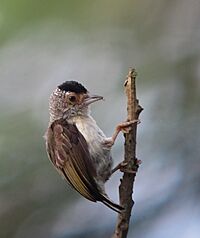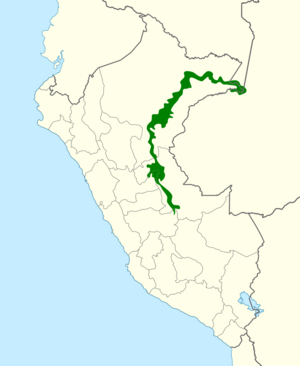Plain-breasted piculet facts for kids
Quick facts for kids Plain-breasted piculet |
|
|---|---|
 |
|
| Conservation status | |
| Scientific classification | |
| Genus: |
Picumnus
|
| Species: |
castelnau
|
 |
|
The plain-breasted piculet (its scientific name is 'Picumnus castelnau') is a small type of bird. It belongs to the woodpecker family, but it's part of a special group called Picumninae. You can find this bird in parts of Brazil, Colombia, and Peru.
Contents
What Kind of Bird Is It?
The plain-breasted piculet is a unique bird, meaning it's the only one of its kind in its group. Scientists are still learning exactly how it fits in with other Picumnus birds. Some experts think it might be closely related to the fine-barred piculet. They might even be able to have babies together!
What Does the Plain-Breasted Piculet Look Like?
This little bird is about 8 to 10 centimeters (3 to 4 inches) long. It weighs around 11 to 12 grams (less than half an ounce). That's about the weight of a few paper clips!
- Males: Adult male piculets have a black cap on their head with cool red tips on some feathers. The sides of their head and the back of their neck are whitish with small black spots. Their face is mostly light brown. Their upper body is a grayish-olive color. Their wing feathers are brown with greenish-yellow edges. Their tail is black, but the inner and outer feathers have white parts. Their belly and chest are a plain, dull yellowish-white. Their eyes are brown, their beak is black with a blue-gray bottom part, and their legs are greenish-yellow to bluish-gray.
- Females: Adult females look almost the same as males, but their whole cap is black with no red tips.
- Young Birds: Young piculets are not as bright as adults. They have faint stripes on their upper and lower bodies.
Where Does the Plain-Breasted Piculet Live?
You can find the plain-breasted piculet mostly along the Ucayali River and the upper Amazon River. Most of these birds live in Peru. A few can also be found in the very southeastern part of Colombia and the far western part of Brazil.
They usually live in forests on river islands and along river banks. They also like to live in forests that have grown back after being cut down. Sometimes, you might even spot them near the edges of farms or gardens. They are most common high up in young Cecropia, Cassia, and Mimosa trees on islands. They can live in places as high as 1,000 meters (about 3,300 feet) above sea level.
How Does the Plain-Breasted Piculet Behave?
What Does It Eat?
The plain-breasted piculet eats small insects. It looks for food on thin branches and stems. It usually feeds about 6 to 15 meters (20 to 50 feet) above the ground. Sometimes, it will look for food lower down along the edges of forests.
This bird hops around on branches, picking, tapping, and poking to find its prey. You might see them alone, in pairs, or in small groups of up to four birds. These groups are probably families. They sometimes join other types of birds to look for food together.
Life Cycle and Reproduction
The plain-breasted piculet's breeding season seems to be from at least May to July. Like other piculets, it probably builds its nest in small holes in trees. However, scientists don't know much about how these birds raise their young.
What Sounds Does It Make?
The plain-breasted piculet has a special song. It's a high-pitched, fast, falling trill that sounds like tree'e'e'e'e'e'e. When it's looking for food, it also makes soft tapping sounds.
Is the Plain-Breasted Piculet in Danger?
The IUCN (International Union for Conservation of Nature) says the plain-breasted piculet is a species of "Least Concern." This means it's not currently in danger of disappearing. We don't know exactly how many of these birds there are, but their numbers are thought to be going down.
No big threats have been found for them right now. They are thought to be "fairly common." They can also live in areas where forests have grown back, which means they can handle some changes to their habitat.


